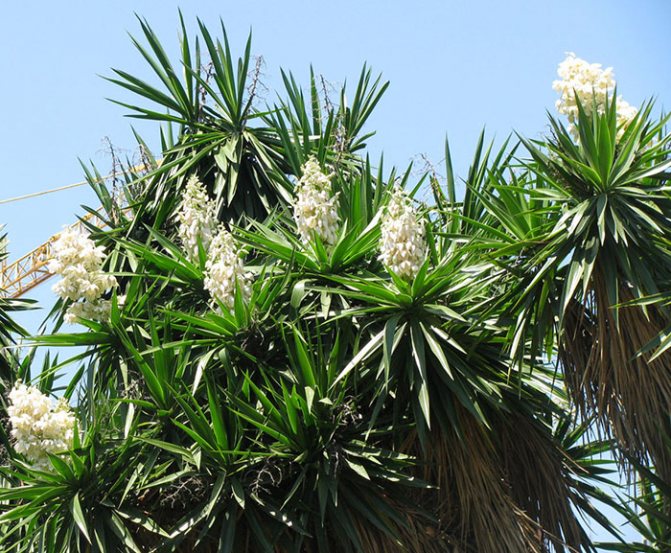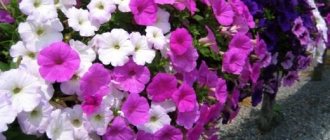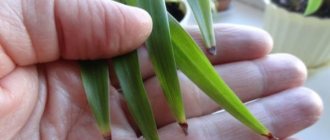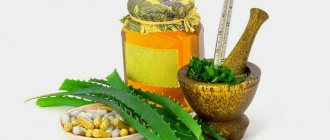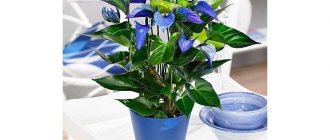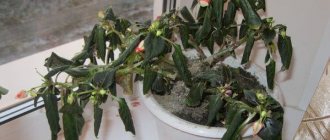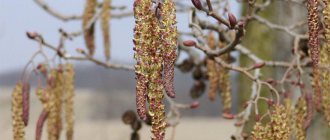Yucca belongs to the Agave family, although this plant is very similar to a palm tree. This family includes over 45 species, but no more than 7 species are cultivated as indoor ornamental, and a few more can be found in gardens and parks. Yucca is popular with flower growers due to its graceful trunk, the top of which is decorated with a shock of beautiful long emerald leaves.
These evergreens are native to North American countries. At home, yucca is cultivated not only as ornamental plants. Yucca is a source of fiber from which clothes, bags, ropes and baskets are made. And from the roots of the culture, local residents have adapted to extract natural red dyes, and parts of the plant are often used by folk healers. Yucca leaves contain starch, so they are often used in cooking.
Causes of yellowing and drying of yucca leaves
The main problem when growing homemade yucca is the loss of decorativeness. The leaves of the plant may turn yellow and dry, but this is not always a consequence of the disease. If only the lower leaves dry out and die off, then this is a natural process of development. And when there is intense leaf fall, then you should find the cause of the problem and eliminate it.
Miniature palm can lose leaves due to improper care or pest infestation:
- The leaves of the culture turn yellow and dry out due to an excess of light, low humidity or improper watering.
- Due to excessive lighting, dry spots form on the leaf plates, so the plant should be protected from the active sun.
- When waterlogged, the leaves become covered with brown spots.
- If the edges and tips of the leaves dry out, then there is not enough humid air in the room, there are drafts or the palm tree does not have enough watering.
- With hypothermia, the leaves of the flower begin to curl and their edges darken.
- Lack of lighting leads to yellowing of the leaves, and the flower shoots are stretched out.
- The formidable enemies of the false palm are scale insects, spider mites, aphids and thrips.
All these parasites settle on the plant and feed on its juices. Therefore, the leaves begin to turn yellow and dry out. If you do not take any measures, then the flower may die.
What does a yucca look like
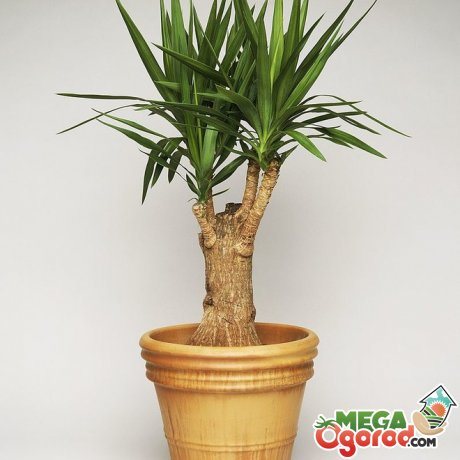
Yucca tree trunks, with one or more growth points, can be crowned with drooping or erect narrow long leaves. With the help of competent pruning, the trunks can be given bizarre shapes and the desired branching. Yucca can bloom and bear fruit only in natural conditions, where they are pollinated by special butterflies. The flowering of decorative varieties can be expected extremely rarely and only from hybrids.
With the creation of favorable conditions and tireless care, homemade yucca can bloom only after 6-7 years. This event takes place in the summer. But experienced gardeners have learned to stimulate the budding of mature plants by creating cool conditions in winter. The temperature at this time should not exceed 14 degrees. Yucca flowers are similar to small white bells and gather in panicle inflorescences.
Ornamental plant species do not grow rapidly, but some specimens can reach four meters in height.
All decorative yucca species have common characteristics that distinguish them from other plants:
- the culture grows like a shrub or tree with a powerful trunk
- emerald leaves of a dense and tough texture, usually monochromatic, but sometimes diluted with white veins
- leaves, the length of which reaches a meter, are collected in rosettes
- panicle inflorescences are formed in the middle of leaf rosettes
After flowering, fruits are formed on the plant - these are berries, which eventually turn into seed pods. In indoor floriculture, two types of yucca can most often be found:
- Elephant, which is often called a false palm. It is a shrub plant with long pointed leaves. The elephant yucca gets its name from its trunk, which thickens significantly with age and resembles an elephant's leg. The homeland of this species is arid regions with a small number of pests, therefore the plant is characterized as unpretentious.
- Aloe leaf - with leathery, tough leaves that resemble aloe leaves. Where did its name come from. To grow this species, you need to make some effort. The crown of an adult plant is spherical and crowned with a thick cylindrical trunk.
All types of yucca have a positive attitude to fresh air, therefore, in the warm season, it is preferable to place the plants outdoors. A place should be chosen with abundant, but diffused sunlight.
Pests
A cute yucca growing in the garden attracts mealybugs, beetles, aphids, thrips. Parasites find decorative perennials in the apartment.


Loading ...
Spider mite
An arthropod insect, the body of which does not exceed half a millimeter in length, has 8 legs. A pest with flowers bought on the market is brought into the room and gets through the air to the lower floors. The spider mite is most often activated during the heating season and begins to feed on juice, and yucca leaves:
- They acquire a yellow tint.
- Are covered with whitish spots.
- Dry up and die off.
To cope with the pest, the windowsill where the yucca is located is washed with water and laundry soap, and wiped with ethyl alcohol. The room is sprayed to increase the humidity, the plant is treated with an insecticide.


Shield aphid or scale insect
Fertile insects adore indoor flowers, attach themselves to green shoots, cling to leaf veins on both sides and drink the juice. After themselves, parasites leave a sticky trail. Yucca stops developing, the young plant may dry out.
You need to know the enemy by sight
In addition to diseases, some insects are among the enemies of yucca. Pests rarely attack a plant with a strong immune system, but diseased, depleted specimens often become their target. Consider who can live on your pet.
Mealybug
Most often it affects the palm tree in the off-season, when the plant is under stress from a change in temperature. Outwardly, the mealybug looks like small cotton rolls, if you crush a fluffy ball, bloody discharge appears. Its harm is enormous, since it sucks juice from leaves and branches, and multiplies very quickly.
If you notice an infestation of a worm, thoroughly wipe the yucca leaves with a sponge dipped in warm soapy water, removing all visible traces of the pest. After that, treat the plant with an insecticide (Aktara, Calypso, Fitoverm, etc.). The procedure must be repeated 3-4 times with an interval of 7-10 days.


Shield
Another dangerous enemy of the yucca is the shield. A tiny insect, similar to a small turtle, is generally mistaken by some for a growth on the leaves, since it is motionless. Deadly attached to a leaf blade or cuttings, the scabbard sucks out the juices of the plant. The first sign of a dangerous neighborhood is sticky, shiny discharge.
Not only the scale insect itself harms the flower, but also the sticky substance. It clogs the pores of living tissue, creating favorable conditions for fungal infections.
The "shell" of the scale insect is so dense that it is difficult to kill it even with chemistry. First, you need to remove adults mechanically - with a swab dipped in concentrated soapy water or vodka, clean the leaves and stems from brown "growths". Remove the topsoil.
Then treat the plant with an insecticide. As with the mealybug, repeat the procedure at least 3 times.
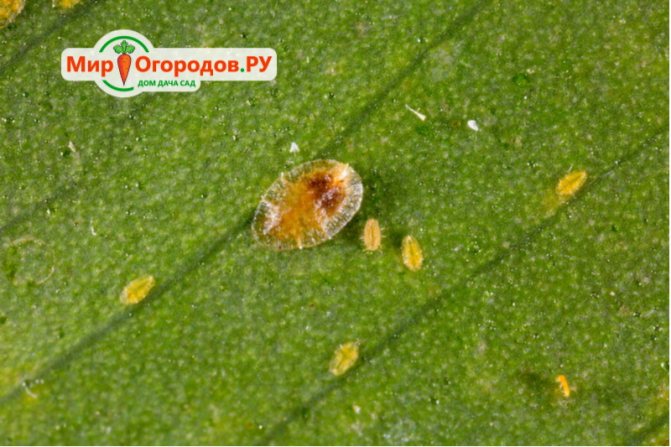

Diseases
With improper care, excessive irrigation in combination with low temperatures, pathogenic microorganisms are activated that cause diseases, which lead to the fact that the yucca loses its decorative effect and sheds its leaves.
Brown spot
With excessive moisture and an insufficient amount of nutrients in the soil, the plant's immunity is weakened, and the palm tree becomes vulnerable to fungi that cause brown spot. Colorless spots appear on the lower leaves. In the absence of attention, the affected areas acquire a yellow color, and after a few months they turn brown, mycelium spores become noticeable. To cure yucca for brown spot, you must:
- Dry the soil in the pot.
- Reduce the amount of irrigation.
- Pluck off infected leaves.
The succulent plant should be treated 3-4 times within 2 weeks with Topaz or the stronger fungicide Ridomil Gold.
Marginal leaf necrosis
Excess moisture helps to activate the Cytospora fungus. The pathogen begins to multiply, but with the timely detection of signs of the disease, yucca can be saved. Gray spots first form at the ends of the leaves, quickly spread to the entire plate, darken, acquire a brown-black color.
Fusarium rot
To cure a succulent from a fungal infection, you need to spray the entire plant with chemicals, from the root to the trunk and top. It is better to remove some of the land, since there are spores in the soil.
When infected with fusarium, the leaves rot at the base and die.
We study yucca diseases and their treatment
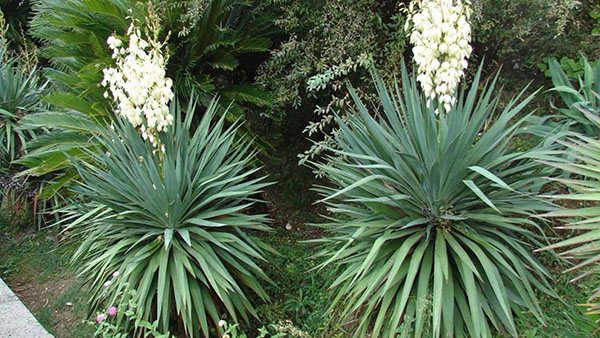

Yucca diseases and their treatment, the photos of which can be seen below, most often appear with the wrong content. This flower is very thermophilic and can easily endure hot weather and droughts. With proper care, it can grow to enormous sizes. However, it can sometimes succumb to various diseases and pests. Therefore, every gardener needs to know what dangers exist, and how to deal with them.
Read also: Review of the IFH 1000 egg incubator
Drying reasons
Why do yucca leaves turn yellow and dry? What to do, how to care for a palm tree to prevent this from happening? How to save? When there is not enough light, the plant also has yellowness on the tips of the leaves, they begin to dry.
If the plant itself dries, its stem, then the problem is a lack of moisture, or it is weakened by some disease. In this case, carefully examine the leaves and stem for the presence or absence of parasites on them.
Bacterial burn
This disease is rare. However, if it affects the plant, then completely and completely. In such cases, gardeners are interested in why the yucca turns yellow and how to save the plant. If you notice spots that eventually acquire a dark black tint, then you are faced with a bacterial burn.
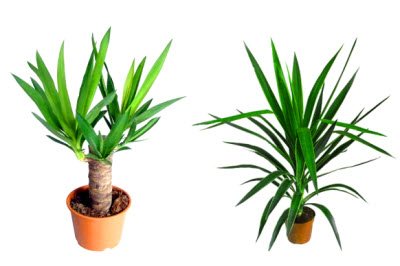

The treatment for this yucca disease (pictured) is very complex. Therefore, in order to avoid such a problem, we recommend that immediately when planting yucca, use only new specially treated pots and soil purchased in the store, which is intended for this type of plant. Thus, you can increase the stamina and resistance of the flower to this type of burn.
It is important to notice a bacterial burn in the very first days of its appearance, because if you do not take any measures in time, it will be impossible to cope with this disease. And you just have to throw your favorite yucca. In the event that you saw several spots of yellow-black color on the leaves, immediately remove the damaged plates, and additionally treat the plant with Bordeaux liquid, or any antibiotic.
Exposure to temperature
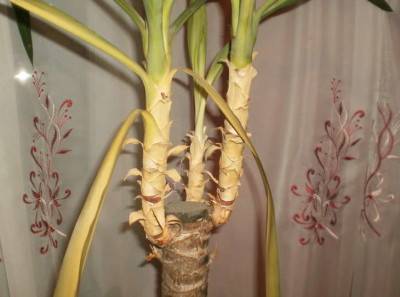

An alarming signal when growing a false palm tree at home is if yucca leaves curl.
Low temperatures have a detrimental effect on the life of the plant, because it comes from the subtropics and categorically cannot stand the cold.
Under the influence of low temperatures the leaves turn brownish at the edges and gradually curl up. There are times when the temperature drops at night and the sensitive yucca freezes overnight. In winter, it is better to remove it from the window sill in the evening until the morning, until it gets warmer.
With severe hypothermia, foliage can fall off en masse. The false palm tree does not tolerate drafts. It is better to take care in advance that the flower is warm and comfortable, especially in winter.
What problems can you face when growing a flower


The basic rule when caring for yucca is to avoid waterlogging of the soil. If you water too often or too much, root rot or other diseases will begin. It is better to underfill a flower than to pour it, since it tolerates drought better than an abundant amount of moisture.
Many do not know what to do when the yucca has dropped its leaves. But it is this fact that most often indicates waterlogging.
The most common problems that occur when growing this plant:
In addition to diseases, yucca can also be affected by a variety of pests. Most often these are whitefly, false shield, slugs, spider mites and mealybugs. How to deal with the above problems, we will consider in this article.
Low lighting
Often in winter, the plant lacks lighting. During the dormant period, this cannot do much harm to him. But if yucca is kept at room temperature even in winter, then during this period it continues to grow. If it does not have enough light, then it stretches, its shoots become thinner, and the leaves turn yellow and sag. So that in winter the yucca does not lose its decorative effect and does not weaken, you need to rearrange it to the most illuminated southern window. Transferring the yucca to the south window is not enough, and to increase daylight hours, you need to arrange for the yucca additional electric lighting
How to feed and fertilize
The arrival of spring indicates that the plant cannot do without feeding. In this case, mineral fertilizers purchased in specialized stores will play the main role. They enter the soil together with water when watering occurs. This procedure should be performed every 10 days during the spring and summer months. With the onset of the autumn period, the feeding period is reduced to 1 time in 3 weeks. Indoor yucca does not require fertilization in winter.
It's important to know!
It is strongly not recommended to fertilize the plant within 14 days after transplanting. It takes time for him to get stronger and start gaining growth.
Violation of watering rules


The individual characteristics of the yucca include adaptability to drought, this must be taken into account when caring for it. The thick trunk of the plant accumulates a lot of moisture (like succulents and cacti), and the dense surface layer of the leaves will prevent them from rapidly losing moisture. But insufficient volume and frequency of watering (especially in summer) will lead to wilting of the leafy part and their gradual withering away. Yucca doesn't like the lack of moisture. The underground part of the flower does not tolerate an excess of moisture in the soil and regular overflow of irrigation water.Yellow, drooping and drying leaves can signal the beginning of rotting of the root of the plant.
It is very important to find a middle ground in this process. The next watering should be carried out only when the soil mixture in the flower pot dries about fifty percent or a little more. Water for irrigation should be warm (with a temperature of 22 to 25 degrees Celsius), always purified or settled. When watering with cold tap water, the base of the stem can begin to rot, and then the root part.
A plant that has become diseased from overflow can only be saved by transplanting it into a new substrate. The plant must be carefully removed from the flower pot, the roots must be thoroughly rinsed, and all rotten parts of the leaves and roots must be removed. After trimming diseased roots, it is recommended to treat the cut sites with activated charcoal or charcoal powder. After that, the houseplant is planted in a new container with fresh soil. If the root part is completely damaged and there is nothing to save, then you can cut off the top of the plant and root it.
Basic rules for plant care
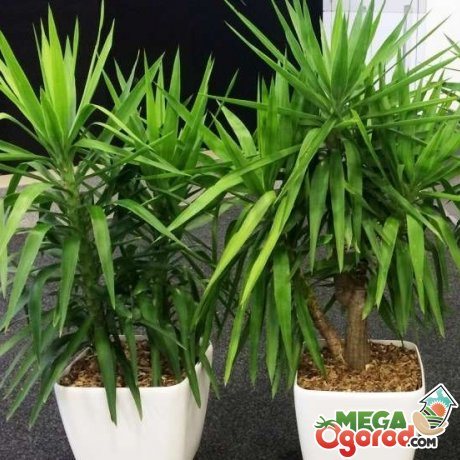

Yucca is notable for its beauty, but in order to preserve the decorative appearance of the plant, you need to properly care for it:
- Lighting. Yucca needs an abundance of light, but direct sunlight has a detrimental effect on plants. Miniature false palms should be placed in western or eastern rooms near windows. If necessary, the duration of daylight hours is increased by means of artificial lighting.
- Temperature conditions. In the summer season, the temperature of the content of plants should not exceed 25 degrees. If the yucca overheats, then it is placed in a cool place and sprayed, and after a while it is returned to its place. In winter, yucca is comfortable at a temperature of 11-13 degrees.
- Irrigation. Watering decorative palms should be given the size of the plant itself and the pot, as well as the temperature and humidity of the air. In summer, abundant watering is needed. The soil should not dry out more than 2 cm. On average, irrigation is carried out once a week with settled water at room temperature. In the autumn-winter time, watering is reduced.
- Spraying. Spraying is carried out in order to prevent spider mites, but excessive waterlogging can lead to a deterioration in the decorative appearance of the plant. Therefore, this procedure should be carried out carefully and in small quantities.
- Priming. For yucca, a ready-made soil mixture for dracaena and palm is suitable, which contains trace elements necessary for the normal development of plants. Also, the soil can be prepared at home by mixing two parts of sod, leafy earth and sand and one part of humus. Such a composition is optimal for young plants, and for adult specimens, a mixture of sod and leafy soil is suitable, to which sand is mixed in a ratio of 3: 2: 1.
- Top dressing. You need to feed the yucca during intensive growth once a month. Mineral and organic compounds are suitable as fertilizers. The solutions are used for spraying the inner sides of the leaves.
- Crown formation. In order for the trunk of the yucca to start branching, it must be cut off. The procedure is applicable for young and healthy plants, no higher than 35 cm. In the second half of spring, two-thirds of the trunk is cut off the yucca. But it is necessary to ensure that leaves or buds remain on the main stem. Sections should be decontaminated to prevent infection. Over time, new shoots will grow from the remaining trunk, and a new plant will grow from the cut off top.
Symptoms and Root Cause Identification
To return the decorativeness to the yucca, you need to understand why it turns yellow and withers. The telltale signs can help you figure out what triggered the problem.
The tips of the leaves dry
Insufficient lighting leads to the fact that the ornamental plant does not look so beautiful.If the tips of the leaves turn yellow and dry out in an evergreen succulent in early spring or late autumn, too dry air may also be the cause of this phenomenon.
To return the plant to an attractive appearance, you must:
- Place the pot farther from the battery.
- Periodically turn on the phytolamp.
- Wipe the above-ground part with a sponge dampened with water.
To increase humidity, yucca is sprayed from a spray bottle. It is often undesirable to start such a procedure, the liquid will accumulate in the leaf sinuses, which is fraught with decay.
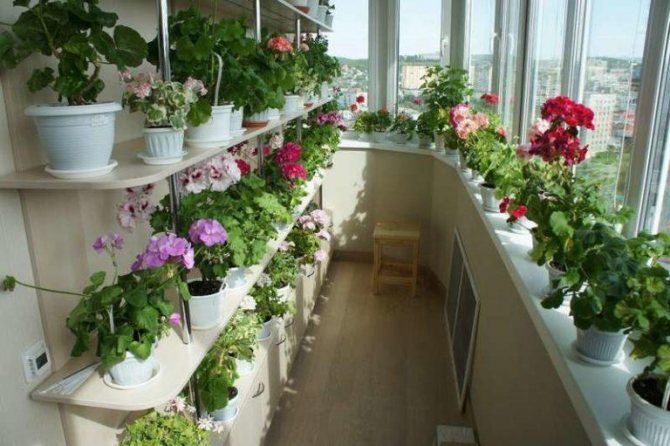

Yellowing and drying of the entire plate
For a palm tree to rest in winter, it must be kept in a cool room. The temperature should not fall below 12 or 13 ° C. Failure to comply with such conditions in combination with poor lighting leads to a weakening of the plant's immunity, the plates turn yellow and dry out both in the old lower leaves and in young rosettes. They become stained and dry when the direct rays of the sun hit the yucca.
To protect the plant from burns, the pot is moved away from the window.
Leaves turn yellow at the stem
With frequent spraying, abundant watering, due to waterlogging, the roots of the plant begin to rot, an unpleasant smell of dampness appears, the stems crack, the leaves turn yellow. To prevent the yucca from dying, they are transplanted into a new pot filled with fresh soil. The intact roots are sprinkled with wood ash, the rotten ones are removed.


The leaves turn black and fall off
When the succulent is located in a draft, at low temperature and high humidity, which occurs in the absence of a drainage layer in the pot and abundant watering, you can see that the tips of the leaves of the yucca have turned black. They fall off when infected with fungi, which are activated when the rules of care are violated, when optimal conditions for a tropical plant are absent.
Leaves are curled
A succulent plant freezes when the air temperature drops to 5 ° C, which can happen if the yucca is left on a balcony or loggia, and it gets colder outside. Perennial leaf edges darken and curl.
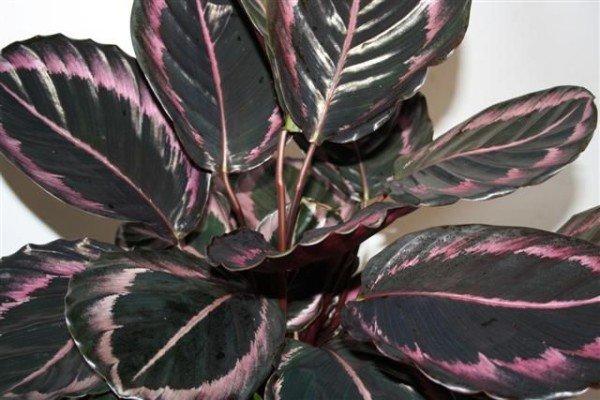

Root and stem rot
With stem rot, similar manifestations are also observed, but already on the stem. And first of all, its lower part is affected. Peculiar red ulcers may also be observed. The cause of this disease is considered to be the frequent changes in the place where the yucca grows. Since it is very difficult to treat yucca in this case, it is recommended to take all measures to prevent the occurrence of such problems.
To do this, you must adhere to the basic rules of care:
- When planting the plant, use only sterile pots and soil.
- Conduct periodic moderate watering, avoiding both waterlogging and drying out of the soil.
- When growing in a room, do not forget about the holes in the pot and the presence of a drainage layer.
Many are looking for how to save a yucca from a soft trunk, because they do not know that it is unrealistic to do this. Therefore, in order not to lose the plant, you need to properly maintain it.
How to save a palm tree from death?
How to reanimate a yucca? Timely response will allow you to reanimate the yucca. It's important to knowwhat to do if it is affected by fungal diseases or pests.
Resuscitation from fungal diseases
If the problem is fungi or bacteria, we get rid of the affected areas of the plant, and the healthy foliage is treated with a systemic fungicide. We reduce watering, do not spray at all.
These are productive measures for the first phase of the disease. When the disease is already actively progressing, the plant cannot be helped. It must be thrown out. We also throw out the pot from under the dead flower.
Drying out of the soil
In winter, when the yucca is at rest, the complete drying out of the earthy coma will not harm the plant. But in the summer, when the palm tree grows intensively, the soil in the yucca pot should not dry out to a depth of more than 5 cm
.
However, inexperienced growers who know about the dangers of waterlogging can very rarely water their plant. At the same time, the soil regularly dries up, which affects the appearance of the plant: the leaves dry and turn yellow, starting from the bottom, and then fall off.
It should be remembered that yucca is not a cactus that is not afraid of drying out the soil. Its roots are different from that of succulents. Frequent drying out of the soil can be detrimental to the plant.
.
What is a home palm tree sick with?
If the yucca leaves turn yellow, measures to save the plant should be taken immediately. Delay can lead to the death of a pet. You need to understand what exactly caused the violations. There are several of the most common diseases.
- 1Yucca spotting develops as a result of increased air humidity. First of all, old stems of the plant suffer. They become stained. Gradually, the disease progresses, spreading to the leaves. They first turn yellow and then brown. To save a palm, treat it with a fungicide. Damaged leaves and sections of the trunk must be removed. You should refrain from spraying, and reduce watering.
- 2 Yellowing of the leaves and rotting of the stem are the main signs that the plant has been attacked by a fungus. Waterlogging of the soil and lack of fresh air contribute to the rapid development of the disease. If the plant is partially affected, it can be easily saved. To do this, it is necessary to remove all decomposed tissues from the trunk as soon as possible and treat with a fungicide. If the disease is started, the affected palm must be immediately disposed of along with the pot. This measure will help prevent infestation of other green pets.
- 3 Cercosporosis is another common ailment. The risk of its occurrence increases with high air humidity. The first symptom is yellow spots on the leaves. Gradually, they acquire a brown tint and increase in size. To combat the disease, you need to abandon spraying and reduce the humidity in the room. It is recommended to cut off the affected stems, and treat the whole plant with a fungicide.
If the disease is detected on time, the plant has every chance of salvation. It is necessary to regularly examine your pet and take the necessary measures at the first symptoms of the disease.
Gray spot


One of the reasons why yucca turns yellow and dries up is gray spotting. This disease develops gradually. First, small specks of a grayish shade with brown edges are formed on the leaves, or the border of the leaf acquires this color. Young shoots are rarely exposed to this disease. As a rule, it affects the lower old sheets.
Fungicides are used to treat this yucca disease (pictured). Remove leaves that are already badly damaged and spray the plant with this preparation. To prevent the disease, use the treatment solution periodically.
Yucca transplant after purchase and during the growing season
Transplant for the first time after purchase, but the plant must first adapt to indoor conditions for about 2 weeks. Carry out a planned transplant in the spring every 2-4 years.
Slightly alkaline soil is preferred. A mixture of turf, compost, humus, perlite and sand is suitable.
Yucca transplant on video:
The container needs to be stable and deep enough. Remove the plant from the pot, inspect the roots for rot. If it is found, prune the roots, treat with a fungicide, completely replace the soil. If the roots are in order, transfer with an earthen lump. Fill up the soil, tamp lightly. Be sure to place a drainage layer on the bottom.
Waterlogging of the soil
Also, waterlogging of the earth and stagnation in the pot should not be allowed. Yucca loves moderate watering, so any waterlogging can cause root rot, which is very difficult to fight.
In the early stages of the disease, it will help in new soil after cutting off all diseased roots and processing the sections with activated carbon.
If the decay has spread to the trunk of the plant, you can root the top of the palm or cut cuttings from healthy branches.
Especially dangerous is waterlogging of the soil in yucca at low temperatures.
.
At rest, the plant almost does not consume water, it needs to be watered very weakly so that the soil remains slightly moist. During this period, even a single abundant watering leads to root rot.
In the summer, watering the yucca with cold water can lead to the onset of the disease. To prevent this from happening, you need to water only with water, the temperature of which is 2-3 degrees higher than the temperature in the room.
Main varieties
In our latitudes, several varieties of yucca are most common, which take root well in different climatic zones, they practically do not require false care measures from the gardener... Among the most popular:
- Filamentous yucca is a plant with large white flowers, practically without a pronounced stem. The characteristic features of this species are long, pointed leaves with white curly filaments along the edges (hence the name of the species). This variety is resistant to cold weather and can be grown practically throughout the territory of our country.
- The glorious yucca is a plant with beautiful red flowers. A distinctive feature of this species is pyramidal inflorescences. It does not withstand temperatures below +13 degrees, it is recommended to grow such a flower in warm areas with the obligatory wrapping of the stem for the winter or transplanting the yucca into a greenhouse.
- Also in horticulture, such less common varieties are known: elephant yucca, aloe leaf, gray. Hybrids vary depending on the size of the plant, the size of the flower, and the shade of the petals.
The species retains the characteristics of its variety when the plant is propagated by any available means. The gardener only needs to correctly perform the division and further planting of the flower, in which case he will not have problems with the young generation.
A little about the plant
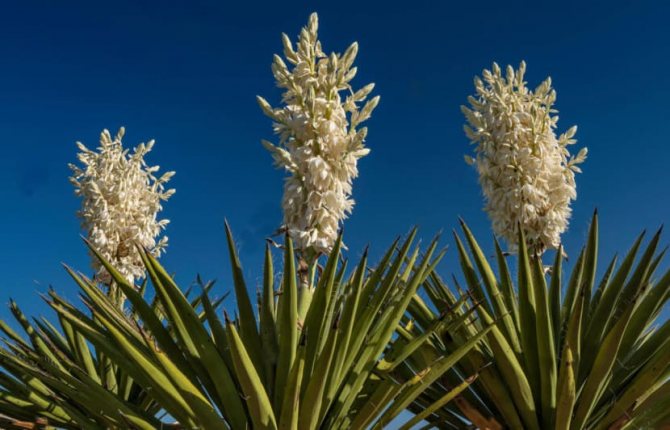

Yucca is a genus of evergreen plants from the Agave family. Visually, these are usually small or medium-sized trees with elongated dense leaves with sharp ends. In total, there are about 50 types of yucca, half of which are bred for outdoor gardening in warm regions of the world and are grown as indoor plants.
Yucca is appreciated not only for its beautiful leaves of a rich green or bluish-green hue, but also for its attractive and unusual flowers. Large buds of all shades from white to cream and pink are strewn with a long peduncle.
Yucca is native to the arid parts of South America. Due to some similarities in appearance associated with conditions in the places of growth, this genus is often confused by beginners in floriculture with palm trees.
What to do if yucca does not bloom


Yucca blooms with a variety of beautiful flowers, painted in various shades. Moreover, the buds should appear every summer, if you adhere to all the rules of care, creating conditions for her that are close to natural. However, unfortunately, not everyone, even experienced gardeners, can achieve this. A prerequisite for the cultivation of yucca is the presence of a long daylight hours, since it loves light very much, as well as the correct temperature. When growing in indoor pots, you will have to be content with only its gorgeous leaves.
Often the owners of such a specimen do not understand why a young plant does not bloom. For the first buds to appear, proper care is required for four to five years.
Growing yucca from seeds
The most commonly used yucca seed propagation.
- The seeds must be scarified: carefully break the dense shell of the seed with a needle or rub it with sandpaper.
- Fill the box with a mixture of leaf, turf and sand in equal proportions. Plant the seeds to a depth of 2-3 cm.
- The distance between the seeds is 3-5 cm, but it is better to plant immediately separately in cassette or peat cups.
- Cover crops with glass or foil. Germinate in an air temperature of 25-30 ° C and bright, diffused lighting.
- Ventilate daily to keep condensation out of the shelter.
- Maintain constant soil moisture for the first 10 days, then moisturize moderately.
- Seedlings will appear in about a month.
- When 2 true leaves appear, plant in separate containers with light nutritious soil.
- After 2 weeks, feed (1 g nitrophoska per 1 liter of water).
- When 4-5 leaves appear, transplant into a pot and care for it as if it were an adult plant.
What to do with brown leaf edges
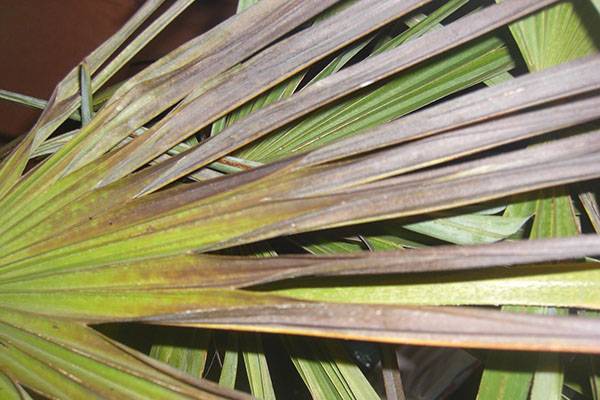

A similar problem is observed when growing a flower indoors. Often, the tips of yucca leaves dry up during the winter period, when the heating season begins. Due to the operation of heating devices, the air in the room becomes very dry, which cannot but affect the condition of the plants. In most cases, the flower copes with such a nuisance. But sometimes the tips of the leaves can still begin to dry out.
To avoid such a disease of indoor yucca, it is necessary to increase the humidity in the room. This can be done in two ways: using special humidifiers, or frequent spraying from a spray bottle.
Another reason for the formation of brown edges on the leaves can be constant drafts. Try changing the location of the plant.
Yucca in landscape design
Yucca is an evergreen representative of the agave, which can be a shrub or a small tree... It is also popularly called a garden palm. The plant blooms with beautiful white flowers, resembling bells in appearance from June to August. With proper care, this period can be extended by a couple of days. The species gives fruits only at home - in Central America or Mexico where the butterfly pollinates flowers.
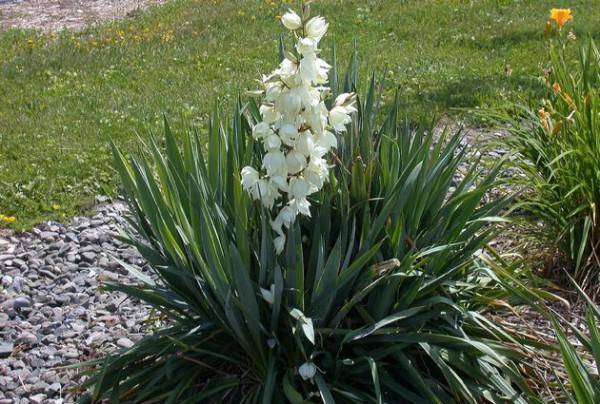

This plant is considered drought-resistant and does not require regular watering from the gardener even at an air temperature of +35 degrees. Flowers are also highly not recommended to be placed in the shade - in the absence of bright sunlight, they fade and wither very quickly. That is why yucca is increasingly placed in open flower beds, the edges of the garden area, and also on the edges of the park. This is where the plant feels at its best. A garden palm tree can grow not only outdoors, but also in pots.
In landscape design, garden yucca is used quite actively. It is planted in flower beds, in parks along the edges of the alley, and is often added to alpine slides and rabatki. The plant looks good on the site at any time of the year and does not require frequent replanting.
About how Gaillardia Hybrid looks like, you can understand by looking at the content of the article.
How to properly care for and grow Monarda Hybrid, you can understand from the article.
Why do yucca leaves fall
This is a very rare occurrence, because the decorative false palm belongs to evergreens and changes in nature do not affect its appearance. If the yucca is happy with its surroundings, it turns green all year round. If a house palm sheds leaves, you need to understand the reason and, if necessary, take action..
The reasons for the sharp exposure of the stem are:
- Stress when changing habitat. The recently purchased yucca just needs to be given time to adapt to the new environment. In this case, transplanting the plant into fresh soil will not interfere. The pot is chosen 2-3 cm larger, drainage from expanded clay is placed on the bottom, soil for palms or cacti is poured on top.
- Rough transplant with damage to the root system. Yucca will adapt and discard young shoots.Any root growth stimulant that is used in accordance with the annotation will help ease the habituation period.
- Frequent watering. Root decay entails wilting of the yucca - death of the stem and discarding of leaves. In this case, you cannot do without a transplant. The rotten parts are removed, the cut of the undamaged lignified top is treated with crushed coal, placed on rooting in wet sand or vermiculite, watered with epin according to the instructions.
- High air temperature in winter with a lack of lighting. How to save yucca from baldness in this case? Provide the plant with coolness (+15 ⁰С) and additional lighting.
What to do with fungal leaf diseases
Overmoistening of the root system or general hypothermia leads to fungal infections
... Dark spots on the leaves are a fungal disease caused by high humidity and excessive watering.
Changing the watering schedule and the constant location of the yucca will help fight the fungus. Diseased leaves are removed.
Another fungus infecting the stem causes stem rot. In the early stages, the fungus can be overlooked; in advanced cases, rot is detected too late, when the stem is affected, and inside it is filled with rot.
If the rot did not have time to spread to the entire trunk, then the plant is cut to healthy tissue and rooted. In advanced cases, it is disposed of together with the pot so that healthy people do not get infected.
Prevention consists in the correct selection of soil
... Fine expanded clay, sand and coconut shavings should become faithful companions of the new soil, the soil will become softer and more airy. Watering in moderation, between waterings, the top layer of the mail should completely dry out.
Yucca is and remains a plant that does not require constant monitoring. The right place is the key to active and healthy growth. Care and, periodic spraying, moderate soil moisture and fertilization will have a positive effect on the appearance.
Many indoor plants growing on the windowsills of our apartments came to us from the tropics. And in order for them to look healthy and beautiful, owners need to be sure to arrange proper care for them. So, a beautiful yucca came to us from the arid regions of Mexico. It is believed that such a culture is quite unpretentious, but sometimes the owners are faced with the fact that it begins to wither. And today we will clarify why the yucca leaves turn yellow and dry, and also tell you what to do in such a situation.
Yucca is similar in appearance to a palm tree and has attractive evergreen leaves. Such a tree grows rather slowly, but it can reach four meters in height. Accordingly, acquiring one, you need to think about the future and find a suitable place for it in your home.
Many owners are faced with the problem of yellowing of the leaves of the yucca. This phenomenon is considered a rather alarming signal, because in the absence of timely intervention, drying out of the foliage can even cause the death of an adult culture. Usually the problem begins in the standard way: the leaves begin to dry out a little at the edges, but over time they turn yellow completely and crumble.
Natural causes
Novice growers should not be afraid if only the lower leaves of the yucca turn yellow, dry up and fall off. After all, this plant periodically drops them, and its upper part remains the same green. This feature is natural and does not require any manipulation.
Shine
As practice shows, most often the yellowing and drying of yucca leaves is provoked by insufficiently correct lighting. Moreover, such a nuisance can be caused by a lack of light or excessive exposure to direct rays of the sun. In the first case, the yucca will simply not have enough lighting for the full implementation of the processes of photosynthesis, and in the second, burns will appear on the leaves, as a result of which they will turn yellow and fall off.
Yucca needs a fairly strong, but diffused lighting. For optimal growth and development, she needs a day of light, with a duration of at least sixteen hours. Accordingly, in the cold season, such a flower will have to provide an additional light source in the form of fluorescent lamps.
Watering
Sometimes yucca leaves darken, turn yellow and fall off if the plant is not watered correctly. Such a culture requires watering only after the soil in the pot dries up by five to seven centimeters. In hot weather, to moisten five liters of soil, it is necessary to use about a liter of soft water warmed up to room temperature. In other seasons, watering is usually more rare and less abundant, but you need to focus on the same signs - on the level of soil drying.
If you water the yucca too much, its roots will rot and the plant will die. In the event that you suspect overflow, remove the plant with care from the pot, inspect its root system. If there are signs of rotting, remove the damaged parts with a sharp knife, treat with a fungicide, and then transplant the plant into fresh soil mixture and a new container. Carry out the next watering only after a week.
Temperature regime
A possible reason for the yellowing of yucca leaves is considered to be sharp temperature changes. Such a plant loves stability. In the warm season, it must be kept at a temperature of about twenty to twenty-five degrees, and in the cold - about twelve degrees. It is important to protect the plant from drafts, temperature fluctuations - it should decrease and increase smoothly.
Nutrients
Yucca can turn yellow and shed foliage if it lacks nutrients. Such a plant needs periodic feeding using solutions of complex mineral compositions. They should be used to spray the underside of the leaves. Many growers say that yucca responds well to the application of the Belarusian fertilizer "Peat Oxidate". Use the chosen product at intervals of two to three weeks during the stage of active growth - in spring and summer.
Tightness
Sometimes yucca begins to wither if its root system does not have enough space for full development. Such a plant must be transplanted at intervals of two to four years into the soil, composed of equal shares of humus, sod soil, compost, as well as sand or perlite. It is important that the acidity of such a soil mixture is in the range of 5.6 - 7.4 pH. When planted in alkaline soil, the plant loses its ability to absorb many nutrients. Of course, it is important to organize the yucca and the drainage layer.
Diseases and pests
Basically, yucca rarely suffers from various ailments or pests. However, such a plant can get sick if it grows in insufficiently favorable conditions. Therefore, when faced with yellowing of the leaves, re-read the rules for caring for yucca and carefully examine it. In case of damage by caterpillars, scale insects, spider mites, thrips or aphids, it is important not only to eliminate the errors of care, but also to treat the flower with insecticides, following the instructions.
Thus, with proper care, yucca leaves should not turn yellow, dry and crumble. Organize favorable conditions for her growth, and she will always delight you with her beauty.
Very often, when growing yucca, flower growers are faced with yellowing and falling of the leaves of this plant. Its leaves dry out at the tips, and then the leaf blades die off completely.
If this happens with 2-3 lower leaves, a natural process of plant growth and development is observed.
But if it intensively loses its leaf mass, it is necessary to look for the reason in the improper care of this palm tree.
Yucca can lose leaves due to poor or abundant watering, too dry air and insufficient lighting. Also, the leaves can dry out and turn yellow when the plant is damaged by pests.
Common diseases of yucca
Most of the diseases of yucca are associated with improper maintenance - waterlogging of the soil, depletion of the soil mixture, and, consequently, weakening of the plant's immunity. But it happens that the infection penetrates from the outside, for example, with a substrate or other indoor flowers. What are the most common problems with a palm tree?
Fungal infections affecting the crown
Several groups of fungi manifest themselves by infecting yucca leaves. All kinds of spots, yellowing, sores appear on them. If you do not catch it in time, the spots increase, merge, in the end, the leaves dry up, and the plant itself wilts. We will tell you how to revive it at home using the example of several diseases.
Cercospora is an infection caused by a causative agent of fungal etiology (Cercospora)
A favorable environment for this fungus is high humidity. It occurs due to constant overflows, as well as when the florist is fond of spraying plants. Rounded spots of light brown color with a dark border appear on the leaves, which gradually grow, affecting new areas.
If you notice the disease, first of all, remove the affected leaves as much as possible.
Then treat with a systemic fungicide, for a start - "light" (Fundazol, Topaz). Number of sprays - 2-3 times with an interval of 10 days.
And, of course, you need to eliminate the factors that led to the disease of the yucca - dry the earthen ball, reduce watering, stop spraying the crown.
Brown spot
The causes of the lesion are similar to the previous disease, but are caused by a fungus of a different group. It primarily affects the lower (old) leaves. First, discolored areas appear, then they turn yellow, and after 3-4 months they acquire a brown color. At this time, you can see fungal spores located in the center of the spots.
Control measures are the same as for cercospora. If the disease has gone far, a stronger fungicide can be used, for example, Ridomil Gold.
Marginal leaf necrosis
This fungal infection is diagnosed by gray-brown spots that affect the edges of the leaf plate. Sometimes the spot can be "weeping", pronounced concentric shape.
If the speck is small, the leaf can not be removed, but only the diseased area can be cut out, capturing part of the healthy tissue. To disinfect the wound, treat the edges with crushed activated carbon.
After the "operation", spray the yucca with the fungicide solution.
Fusarium rot
This is a dangerous fungal infection leading to leaf rot. They are struck, as a rule, at the base and completely rot away.
To combat fusarium fungus, systemic fungicides are used, such as Fundazol, Previkur, Profit. If the lesion is severe, it is better to discard the plant along with the pot.
In order for the fight against diseases and pests to be effective, the crown, trunk and, necessarily, the soil are sprayed. Sometimes it is recommended to remove the top layer of the substrate infected with fungal spores or insect larvae. In case of fungal diseases, for safety reasons, the plant is not only sprayed, but also watered several times with a weak solution of the fungicide.
In the photo - a yucca affected by cercospora
Stem rot
If the loss of leaves is a temporary problem, after treatment new ones will grow, then with the trunk it is not so simple. This is the main artery through which food flows, if it dies, the yucca will also die.
The rotten trunk becomes soft, brown sores appear on it, from which a watery substance oozes.
Only surgical intervention can save the plant.
The softened part of the trunk is unambiguously cut out to healthy tissue. Further actions depend on what is left of the palm tree.
If this is the tip, the cut is dried, treated with a growth stimulant (according to the instructions) and try to root. This can be done in water or in a light peat and perlite substrate.
A living root with a part of the trunk? Perfectly! Treat the cut with activated or crushed charcoal, place in a bright, warm place. Drizzle with a solution of the fungicide Carbendazim to kill the fungus in the soil. If everything goes well, the yucca will expel the shoots from the axillary buds.
You can try to germinate healthy fragments of the yucca trunk in the substrate by burying them flat.
Root problems
Often on the forums you can "hear" the cry of the soul: "The yucca is dying, what to do?" And outwardly everything looks normal - no obvious diseases, no pests, and the plant is withering away. In situations like this, the problem is most likely in the roots.
Root rot is a nightmare for succulents, which include yucca. It can only be seen when transplanting a plant. Therefore, if you see that the plant decays for no apparent reason, try to carefully remove it from the pot and examine the roots. If they are dark and soft, it is root rot. Whether it will be possible to reanimate the yucca depends on the degree of damage.
- If the roots have rotted completely, all that remains is to discard the flower.
- Less than a third of diseased roots? Cut off anything suspicious, transplant the yucca into a new container with fresh substrate. After planting, pour the fungicide solution and send the "sick" person to a warm and bright place.
- If more than half of the roots are damaged, but not all, you can try to save the plant. They need to be rinsed under the tap, and then cut off all soft and darkened pieces. Next, we plant it, pour it with a fungicide solution, set it to light. We are waiting for the result.
A reanimated plant should not be watered until you are sure that it has taken root and has begun to grow.
Healthy roots - light and firm
Yucca does not bloom
Some growers are worried about the question of why yucca does not bloom, they even tend to attribute the problem to the disease or to the wrong content. This is not entirely true.
The fact is that yucca almost never blooms in "captivity". This is due to the fact that the conditions of its maintenance are far from the natural environment, the dormant period is relative, which means that the flower buds do not have time to mature. And in natural conditions, only adult "palms" bloom. Therefore, if the yucca is more than 10 years old and in winter you provide her peace, there is a chance that she will throw out inflorescences with beautiful white bells, albeit a small one.
If you want to see how yucca blooms, grow garden plant varieties.
Brown spot


A similar disease is caused by the fungi Coniothyrium concentricum. The peculiarity of this ailment is that it first appears on the lower leaves. It is the plates that are located and the very base that microorganisms infect in the first place. At first, colorless areas can be seen on the leaves, which turn yellow over time. After a few weeks, these spots turn brown.
To remedy the situation, immediately treat with fungicides, for example, such as:
- Vitaros;
- Oxyhom;
- Alirin-b.
Such preparations should be diluted in the proportions indicated on the packaging and sprayed with a spray bottle. Repeated treatments should be carried out every ten days. Leaves that could not be saved are best cut off completely.
Try to maintain proper humidity and temperature conditions to prevent brown spotting. Watch your watering frequency. Both abundant irrigation and its complete absence are not allowed.
Painful conditions
The tips of the leaves dry
Florists noted that the most common causes of yellowing and drying of leaf tips are:
- lack of lighting in the winter;
- ear air.
A decrease in daylight hours from October to the end of February, as well as cloudy weather, are factors that adversely affect the appearance of a palm tree. Yucca leaves lose color, stretch, turn yellow.Drying of the tips is traced, sometimes accompanied by a loss of leaf turgor. Phytolamps (any other artificial lighting) will help to correct the situation.
On a note! Diffused light up to 10-12 hours a day will stop the yellowing of the tips, return the palm to a healthy look.
Dry air during the heating season is the second common cause of drying out of the ends of the sheet plate. In winter, the yucca should not be kept near a battery or other heating devices. It is important to take care of regular room air humidification. Periodic wiping of the leaves with a wet sponge will also help keep the palm healthy.
On a note! Frequent and excessive spraying of the plant with a puller leads to the accumulation of water in the leaf axil and its decay.
Yellowing and drying of the entire plate
Yucca has a pronounced dormant period. In winter, the palm tree must rest in order to begin to build up its vegetative mass with renewed vigor in the spring. Keeping the plant in a warm room, jumps in air temperature during ventilation, drafts, abundant and frequent watering do not allow the yucca to fully rest, its immunity weakens. As a result, not only the lower leaves, but also the young rosette begin to turn yellow, lose turgor and dry out.
The correct conditions for keeping the plant in winter:
- stable humid air;
- coolness (10-15 degrees) without drafts;
- lighting for about 10-12 hours;
- watering once every 2-4 weeks.
If the leaves of the palm tree are covered with yellow dry spots in summer, direct sunlight is to blame. Yucca got burns. The way out is to remove the plant in an area with diffused light or in partial shade.
Leaves turn yellow at the stem
Often there is a situation when the leaf begins to turn yellow (or brown) from the base, gradually covering the entire plate. At the same time, no drying is observed. The plant wilts, withers.
Common causes of the disease:
- spraying a palm tree from a puller;
- content in a draft;
- waterlogging of the soil.
Frequent watering of the soil, especially during dormancy, causes root rot, stem cracking and yellowing of foliage. How to save the plant in this case? Remove the palm from the pot, remove the rotten roots, and treat the healthy ones with charcoal. Transplant the yucca into new soil. Soil mixture for transplanting: 1 part each of sand and sod soil, 2 parts of a universal substrate.
This measure will not help if the barrel has lost its elasticity, has become hollow inside. Then the yucca will have to be cut into cuttings and try to root at least one of the healthy areas.
The rate of watering a false palm in winter during the dormant period is 1 time per month!
Lack of micronutrients
If the home growing conditions for the yucca are close to ideal, and the plant still turns yellow, you should pay attention to the quality of the soil in the flower pot. The palm tree is clearly lacking in nutrients. What to do to bring back a blooming yucca?
First, it is necessary to establish what substance the plant needs. Secondly, choose one of the proposed options for action:
- the palm tree can be transplanted into a new enriched soil (during the period of awakening and active growth);
- greens can be sprayed with a suitable composition according to the instructions (for example, iron chelate).
Table - diagnostics of the state of the plant
appearance
scarce element
lack of magnesium, iron
A one-time action will not save the situation. The drug will have to be used several times according to the manufacturer's recommendations.
Reproduction methods
Garden yucca is propagated mainly by dividing the roots or lateral processes. It is recommended to spend it in the spring. The ideal time for this kind of work is March. Reproduction is carried out as follows:
- the plant is carefully dug out so as not to damage the root system;
- cuttings up to 5 cm long are cut from the rhizome;
- the resulting fragments are dried in the fresh air for 4 hours, then they are planted in a greenhouse to a depth of 5-7 cm. For this purpose, it is worth using a loamy soil.
After the seedlings sprout, the film is removed. With the arrival of spring or autumn (depending on the time of the division), the plants are transplanted to a sunny, warm area of open ground.
The division by shoots and leaves is carried out in a similar way. However, this method is considered less productive, because it is practically not practiced by private farms.
Yellowing within normal limits
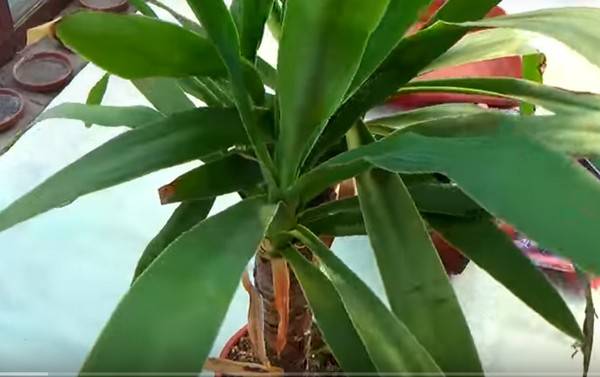

The plant is absolutely healthy. It's time to turn the lower fragments into trunk scales
Indoor yucca is often referred to as a false palm tree for its distinctive appearance. Uniform aging, yellowing and drying of the lower row of leaves is normal for this plant. The woody trunk practically does not branch. The crown of the stem is crowned with a bunch of linear-lanceolate pointed leaves, giving the plant an exotic look.
To increase the decorativeness of the palm, the lower row of yellowed leaves is simply cut off, leaving the healthy and strong greenery intact.
Low humidity
If the plant is kept at room temperature in a heated room in winter, its leaves may dry out due to a lack of moisture in the air.
Yucca tolerates low humidity well, but if the air is very dry and the plant is located near heating devices, then even such an unpretentious plant may begin to turn yellow.
In the cold period, you must first of all remove the yucca from the heating radiators.
... This is usually enough to stop the leaves from drying and turning yellow. You can artificially humidify the air near the plant by placing it in a pan with wet sand, expanded clay or moss.



